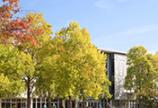A passion for learning, curating and decolonizing
- John Threlfall
While a passion for Indigenous arts has been driving Mel Granley’s studies in the art history and visual studies department, it was their connection with the natural world that initially attracted them to UVic. “It’s kind of silly, but rabbits have always been really important in my life; if I see a rabbit, I know I’m on the right path.” So when they first visited UVic back in grade 9—at the height of the campus bunny infestation—Granley took it as a good sign. “When I got accepted at UVic, however, the rabbits were gone,” they say with a chuckle. “But it was a really good decision to come here; I wouldn’t change it for anything.”
Initially studying linguistics, the Alberta-raised Granley soon realized their talents lay elsewhere (“I was terrible at it,” they admit)—but, as is often the case, a simple elective led to greater things. “I took an introduction to art history course and thought, ‘This is it—this is the thing for me!’”
Their major in art history, plus courses in both Indigenous and gender studies, led Granley to develop a focus on Indigenous arts and activism; this, combined with a summer 2018 internship with UVic’s LE,NOṈET Indigenous support program, resulted in their current seven-month position at downtown’s Legacy Art Gallery. As Legacy’s curatorial intern and visitor engagement assistant, they greet visitors, talk about art, offer elementary school tours and assist with exhibits. “The amount of physical, manual effort that goes into installation week was totally surprising to me,” they laugh. “You don’t realize how much work goes into an exhibit when you’re just studying.”
As they prepare to graduate this month with a Bachelor of Arts in art history and visual studies, Granley is now seeing a concrete activation of their academic studies: in addition to preparing to curate two exhibits for First Peoples House in 2020, they recently assisted with the installation of the Legacy exhibit We Carry Our Ancestors: Cedar, Baskets and Our Relationships with the Land, curated by Lorilee Wastasecoot.
“I did my honour’s thesis on decolonizing museum and gallery spaces and the repatriation of what I consider stolen objects, so it’s been very interesting to actually work in a gallery space,” says Granley, who is Métis on their mother’s side. “Trying to decolonize a collection is difficult, because people often don’t want to relinquish items, as their collection then gets smaller. But from working here, I’ve seen real efforts are being made towards decolonization; the staff even asked for my input—as an intern, I felt really lucky to be part of that.”
Granley points to We Carry Our Ancestors as a good example of gallery decolonization practices. “It’s not only displaying Indigenous baskets, it was put together by an Indigenous person using Indigenous methodologies,” they explain. “It’s very different from other basketry exhibits, and I feel very lucky that I got to help put it together and work with Lorilee. It’s been important for me to have another Indigenous person guide and help me with my own curating.”
Looking to the future, Granley anticipates doing graduate work (“I’m not sure what I’ll do as a career path, but I really like UVic and my heart wants me to apply here”) and realizes they have accumulated invaluable concrete skills as an art history student (recording and transcribing live interviews, researching and writing for websites, object handling and curatorial practices).
“I feel like I learned so much,” they say. “It was a very rounded education . . . the art history professors are so supportive of their students, and really take a lot of interest in them. I’m really grateful for the support of the department and First Peoples House, as well as my friends and family. I wouldn’t have been able to get my degree without them.”
Whatever their career path, Granley is certain their passion for Indigenous arts and activism will remain strong. “Items that have been taken out of Indigenous communities are direct ancestors from those nations and those peoples,” they insist. “The idea of keeping items locked up in storage away from their people and other objects is just wrong.”

